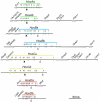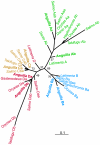Primitive duplicate Hox clusters in the European eel's genome
- PMID: 22384188
- PMCID: PMC3286462
- DOI: 10.1371/journal.pone.0032231
Primitive duplicate Hox clusters in the European eel's genome
Abstract
The enigmatic life cycle and elongated body of the European eel (Anguilla anguilla L., 1758) have long motivated scientific enquiry. Recently, eel research has gained in urgency, as the population has dwindled to the point of critical endangerment. We have assembled a draft genome in order to facilitate advances in all provinces of eel biology. Here, we use the genome to investigate the eel's complement of the Hox developmental transcription factors. We show that unlike any other teleost fish, the eel retains fully populated, duplicate Hox clusters, which originated at the teleost-specific genome duplication. Using mRNA-sequencing and in situ hybridizations, we demonstrate that all copies are expressed in early embryos. Theories of vertebrate evolution predict that the retention of functional, duplicate Hox genes can give rise to additional developmental complexity, which is not immediately apparent in the adult. However, the key morphological innovation elsewhere in the eel's life history coincides with the evolutionary origin of its Hox repertoire.
Conflict of interest statement
Figures







Similar articles
-
[Chromosomal localization of rice field eel Hox genes by PRINS].Yi Chuan Xue Bao. 2002 Jul;29(7):612-5. Yi Chuan Xue Bao. 2002. PMID: 12143310 Chinese.
-
Hox genes of the Japanese eel Anguilla japonica and Hox cluster evolution in teleosts.J Exp Zool B Mol Dev Evol. 2010 Mar 15;314(2):135-47. doi: 10.1002/jez.b.21318. J Exp Zool B Mol Dev Evol. 2010. PMID: 19670462
-
De novo European eel transcriptome provides insights into the evolutionary history of duplicated genes in teleost lineages.PLoS One. 2019 Jun 12;14(6):e0218085. doi: 10.1371/journal.pone.0218085. eCollection 2019. PLoS One. 2019. PMID: 31188893 Free PMC article.
-
Hox gene duplication in fish.Semin Cell Dev Biol. 1999 Oct;10(5):531-40. doi: 10.1006/scdb.1999.0334. Semin Cell Dev Biol. 1999. PMID: 10597637 Review.
-
Saving the European Eel: How Morphological Research Can Help in Effective Conservation Management.Integr Comp Biol. 2020 Aug 1;60(2):467-475. doi: 10.1093/icb/icaa004. Integr Comp Biol. 2020. PMID: 32108900 Review.
Cited by
-
Surviving in a toxic world: transcriptomics and gene expression profiling in response to environmental pollution in the critically endangered European eel.BMC Genomics. 2012 Sep 25;13:507. doi: 10.1186/1471-2164-13-507. BMC Genomics. 2012. PMID: 23009661 Free PMC article.
-
Synteny and phylogenetic analysis of paralogous thyrostimulin beta subunits (GpB5) in vertebrates.PLoS One. 2019 Sep 19;14(9):e0222808. doi: 10.1371/journal.pone.0222808. eCollection 2019. PLoS One. 2019. PMID: 31536580 Free PMC article.
-
Duplication and subfunctionalisation of the general transcription factor IIIA (gtf3a) gene in teleost genomes, with ovarian specific transcription of gtf3ab.PLoS One. 2020 Jan 30;15(1):e0227690. doi: 10.1371/journal.pone.0227690. eCollection 2020. PLoS One. 2020. PMID: 31999691 Free PMC article.
-
Multiple kisspeptin receptors in early osteichthyans provide new insights into the evolution of this receptor family.PLoS One. 2012;7(11):e48931. doi: 10.1371/journal.pone.0048931. Epub 2012 Nov 20. PLoS One. 2012. PMID: 23185286 Free PMC article.
-
Assessing patterns of hybridization between North Atlantic eels using diagnostic single-nucleotide polymorphisms.Heredity (Edinb). 2014 Jun;112(6):627-37. doi: 10.1038/hdy.2013.145. Epub 2014 Jan 15. Heredity (Edinb). 2014. PMID: 24424165 Free PMC article.
References
-
- Tesch F-W. The eel. Oxford: Blackwell Publishing; 2003.
-
- Als TD, Hansen MM, Maes GE, Castonguay M, Riemann L, et al. All roads lead to home: panmixia of the European eel in the Sargasso Sea. Mol Ecol. 2011;20:1333–1346. - PubMed
-
- Avise JC, Nelson WS, Arnold J, Koehn RK, Williams GC, et al. The evolutionary genetic status of Icelandic eels. Evolution. 1990;44:1254–1262. - PubMed
-
- Schmidt J. Breeding places and migration of the eel. Nature. 1923;111:51–54.
-
- Aarestrup K, Okland F, Hansen MM, Righton D, Gargan P, et al. Oceanic spawning migration of the European eel (Anguilla anguilla). Science. 2009;325:1660. - PubMed
Publication types
MeSH terms
Substances
Associated data
- Actions
- Actions
- Actions
- Actions
- Actions
- Actions
- Actions
- Actions
- Actions
- Actions
LinkOut - more resources
Full Text Sources

